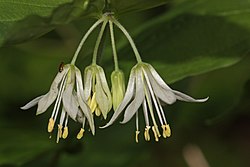| Prosartes hookeri | |
|---|---|
 | |
| John B. Yeon State Park, Oregon | |
| Scientific classification | |
| Kingdom: | Plantae |
| Clade: | Tracheophytes |
| Clade: | Angiosperms |
| Clade: | Monocots |
| Order: | Liliales |
| Family: | Liliaceae |
| Genus: | Prosartes |
| Species: | P. hookeri |
| Binomial name | |
| Prosartes hookeri | |
| Synonyms [1] | |
| |
Prosartes hookeri is a North American species of flowering plants in the lily family known by the common names drops of gold and Hooker's fairy bells. [2] [3]
